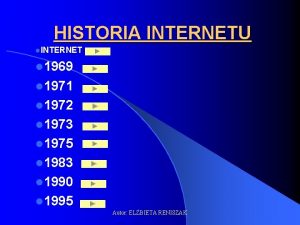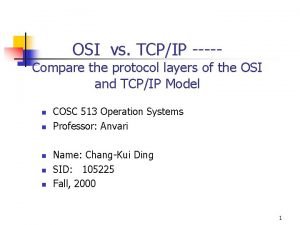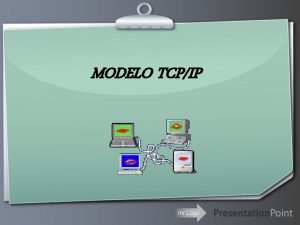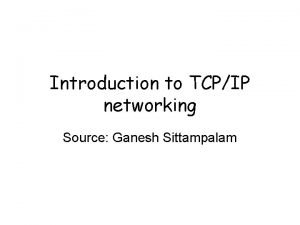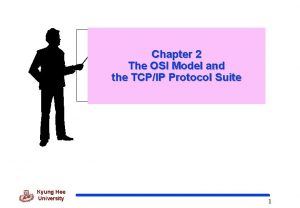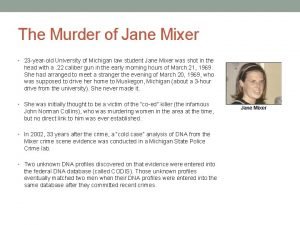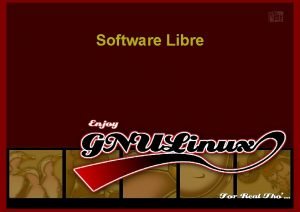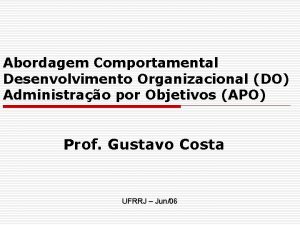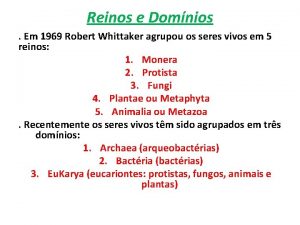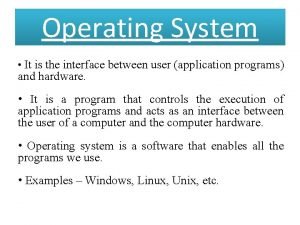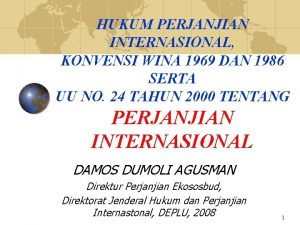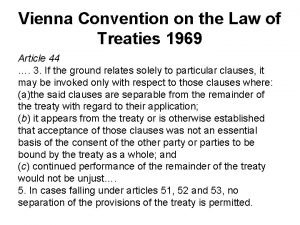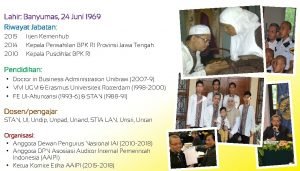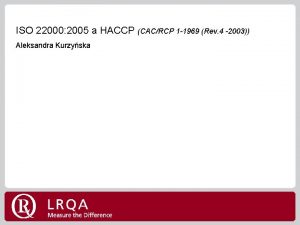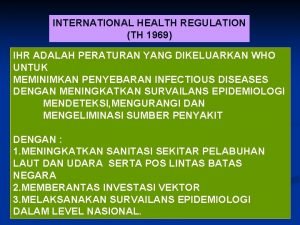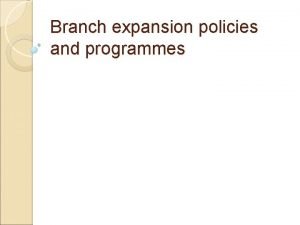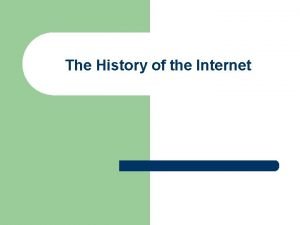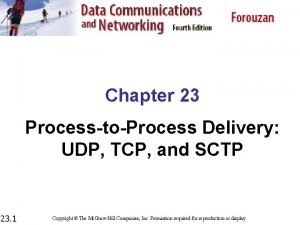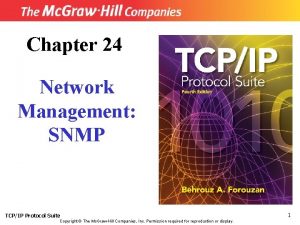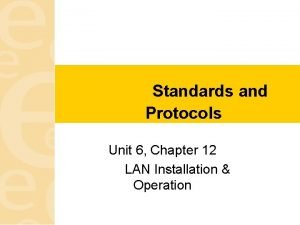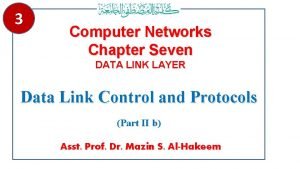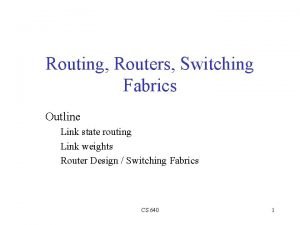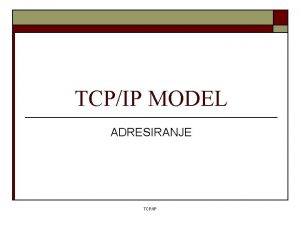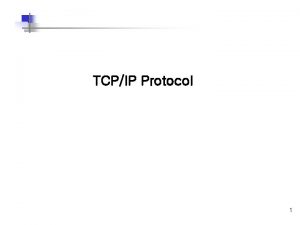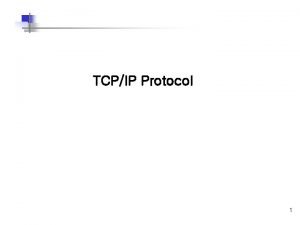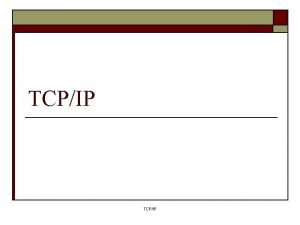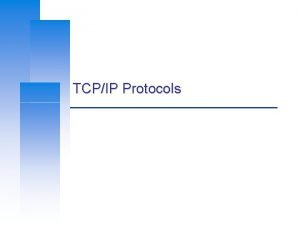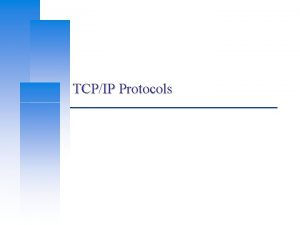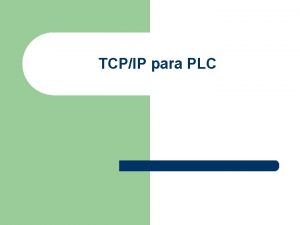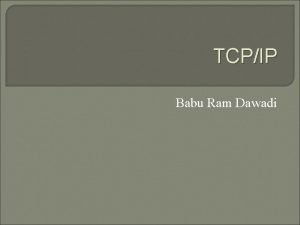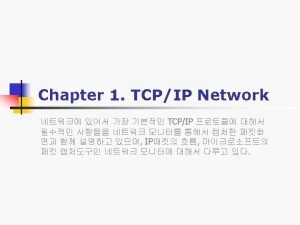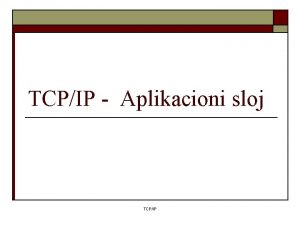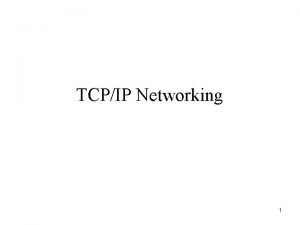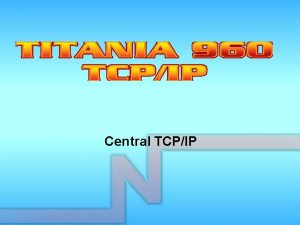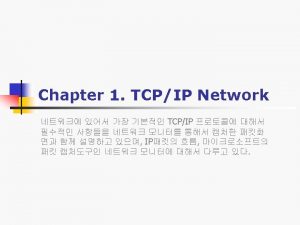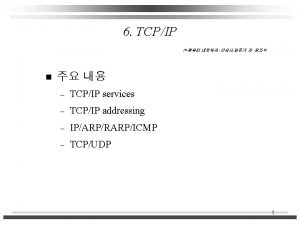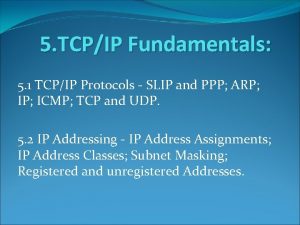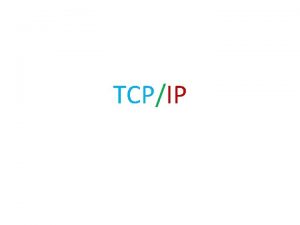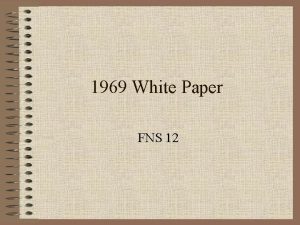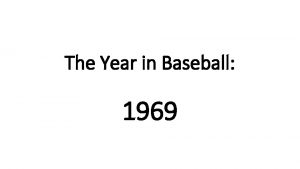TCPIP Protocols TCPIP and the Internet In 1969

























































































- Slides: 89

TCP/IP Protocols

TCP/IP and the Internet > In 1969 – ARPA funded and created the “ARPAnet” network • Robust, reliable, vendor-independent data communications > In 1975 – Convert from experimental to operational network – TCP/IP begun to be developed > In 1983 – The TCP/IP is adopted as Military Standards – ARPnet MILNET + ARPnet = Internet > In 1985 – The NSF created the NSFnet to connect to Internet > In 1990 – ARPA passed out of existence, and in 1995, the NSFnet became the primary Internet backbone network ARPA = Advanced Research Project Agency NSF = National Science Foundation 2

Introduction (1) > TCP/IP – Used to provide data communication between hosts • • • How to delivery data reliably How to address remote host on the network How to handle different type of hardware device – 4 layers architecture • • Each layer perform certain tasks Each layer only need to know how to pass data to adjacent layers 3

Introduction (2) > Four layer architecture – Link Layer (Data Link Layer) • • Network Interface Card + Driver Handle all the hardware detail of whatever type of media – Network Layer (Internet Layer) • Handle the movement of packets on the network – Transport Layer • Provide end-to-end data delivery services – Application Layer • Handle details of the particular application 4

Introduction (3) > Various Address – MAC Address • Media Access Control Address 48 -bit Network Interface Card Hardware Address • Ex: • > 24 bit manufacture ID > 24 bit serial number > 00: 07: e 9: 10: e 6: 6 b – IP Address • • 32 -bit Internet Address Ex: – Port • • > 140. 113. 209. 64 16 -bit uniquely identify application Ex: > FTP port 21, ssh port 22, telnet port 23 5

Introduction (4) > Each layer has several protocols – A layer define a data – communication function that may be performed by certain protocols A protocol provides a service suitable to the function of that layer 6

Introduction (5) > Send data – encapsulation 7

Introduction (6) > Addressing – Nearby (same network) 8

Introduction (7) > Addressing – Faraway (across network) 9

Introduction (8) > Receive Data – Demultiplexing 10

Link Layer

Introduction of Link Layer > Purpose of the link layer – Send and receive IP datagram for IP module – ARP request and reply – RARP request and reply > TCP/IP support various link layers, depending on the type of hardware used: – Ethernet • Teach in this class – Token Ring – FDDI (Fiber Distributed Data Interface) – Serial Line 12

Ethernet > Features – Predominant form of local LAN technology used today – Use CSMA/CD • Carrier Sense, Multiple Access with Collision Detection – Use 48 bit MAC address – Operate at 10 Mbps • Fast Ethernet at 100 Mbps – Ethernet frame format is defined in RFC 894 • This is the actually used format in reality 13

Ethernet Frame Format > 48 bit hardware address – For both destination and source address – 16 bit type is used to specify the type of following data • • 0800 IP datagram 0806 ARP, 8035 RARP 14

Loopback Interface > Pseudo NIC – Allow client and server on the same host to communicate – with each other using TCP/IP IP • 127. 0. 0. 1 – Hostname • localhost 15

MTU > Maximum Transmission Unit – Limit size of payload part of Ethernet frame • 1500 bytes – If the IP datagram is larger than MTU, • IP performs “fragmentation” > MTU of various physical device > Path MTU – Smallest MTU of any data link MTU between the two hosts – Depend on route 16

Network Layer

Introduction to Network Layer > Unreliable, connectionless datagram delivery service – IP Routing – IP provides best effort service (unreliable) – IP datagram can be delivered out of order (connectionless) > Protocols using IP – TCP, UDP, ICMP, IGMP 18

IP Header (1) > 20 bytes in total length, excepts options 19

IP Header (2) > Version (4 bit) – 4 for IPv 4 and 6 for IPv 6 > Header length (4 bit) – The number of 32 bit words in the header (15*4=60 bytes) – Normally, the value is 5 (no option) > TOS-Type of Service (8 bit) – 3 bit precedence + 4 bit TOS + 1 bit unused > Total length (16 bit) – Total length of the IP datagram in bytes 20

IP Header (3) > Identification (16 bit) > Fragmentation offset (13 bit) > Flags (3 bit) – All these three fields are used for fragmentation 21

IP Header (4) > TTL (8 bit) – Limit of next hop count of routers > Protocol (8 bit) – Used to demultiplex to other protocols – TCP, UDP, ICMP, IGMP > Header checksum (16 bit) – Calculated over the IP header only – If checksum error, IP discards the datagram and no error message is generated 22

IP Routing (1) > Difference between Host and Router – Router forwards datagram from one of its interface to – another, while host does not Almost every Unix system can be configured to act as a router or both > Router – IP layer has a routing table, which is used to store the – information forwarding datagram When router receiving a datagram • • If Dst. IP = my IP, demultiplex to other protocol Other, forward the IP based on routing table 23

IP Routing (2) > Routing table information – Destination IP – IP address of next-hop router or IP address of a directly connected – – network Flags Next interface > IP routing – Done on a hop-by-hop basis – It assumes that the next-hop router is closer to the destination – Steps: • Search routing table for complete matched IP address • Search routing table for matched network ID • Search routing table for default route • host or network unreachable > Send to next-hop router or to the directly connected NIC > Send to this default next-hop router 24

IP Routing (3) > Ex 1: routing in the same network – bsdi: 140. 252. 13. 35 – sun: 140. 252. 13. 33 Ex Routing table: 140. 252. 13. 33 00: d 0: 59: 83: d 9: 16 UHLW fxp 1 25

IP Routing (4) > Ex 2: – routing across multi-network 26

IP Address (1) > 32 -bit long – Network part • Identify a logical network – Host part • Identify a machine on certain network > IP address category 27

IP Address (2) > Ex: – NCTU • • • Class B address: 140. 113. 0. 0 Network ID: 140. 113 Number of hosts: 255*255 = 65535 > Problems of Class A or B network – Number of hosts is enormous – Hard to maintain and management – Solution subnetting 28

subnetting and netmask (1) > Subnetting – Borrow some bits from network ID to extends hosts ID – Ex: • • Class. B address : 140. 113. 0. 0 = 256 Class. C-like IP addresses in N. N. N. H subnetting method 140. 113. 209. 0 subnet > netmask – Specify how many bits of network-ID are used for network-ID – Continuous 1 bits form the network part – Ex: • 255. 0 in NCTU-CSIE example > 256 hosts available • 255. 248 in ADSL example > Only 8 hosts available – Shorthand notation • Address/prefix-length > Ex: 140. 113. 209. 8/24 29

subnetting and netmask (2) > How to determine your network ID? – Bit-wise-and IP and netmask – Ex: • • 140. 113. 214. 37 & 255. 0 140. 113. 214. 0 140. 113. 209. 37 & 255. 0 140. 113. 209. 0 • 140. 113. 214. 37 & 255. 0. 0 140. 113. 0. 0 140. 113. 209. 37 & 255. 0. 0 140. 113. 0. 0 • 211. 23. 188. 78 & 255. 248 211. 23. 188. 76 • > 78 = 01001110 > 78 & 248= 01001110 & 11111000 =72 30

subnetting and netmask (3) > In a subnet, not all IP are usable – The first one IP network ID – The last one IP broadcast address – Ex: • • Netmask 255. 0 140. 113. 209. 32/24 • 140. 113. 209. 0 network ID 140. 113. 209. 255 broadcast address 1 ~ 254, total 254 IPs are usable • Netmask 255. 252 • • – Ex: • 211. 23. 188. 78/29 • 211. 23. 188. 72 network ID 211. 23. 188. 79 broadcast address 73 ~ 78, total 6 IPs are usable • • 31

subnetting and netmask (4) > The smallest subnetting – Network portion : 30 bits – Host portion : 2 bits 4 hosts, but only 2 IPs are available > ipcalc. pl 32

subnetting and netmask (5) > Benefits of subnet – Reduce the routing table size of Internet’s routers – Ex: • All external routers have only one entry for 140. 113 Class B network > Problems of Class C network – 255*255 number of Class C network make the size – of Internet routes huge Solution • Classless Inter-Domain Routing 33

CIDR > Classless Inter-Domain Routing – Use address mask instead of old address classes to determine – the destination network CIDR requires modifications to routers and routing protocols • Need to transmit both destination address and mask > Benefit of CIDR – We can allocate continuous Class. C network to organization • • Reflect physical network topology Reduce the size of routing table 34

ARP – Address Resolution Protocol and RARP – Reverse ARP

ARP and RARP > Mapping between IP and Ethernet address > When an Ethernet frame is sent on LAN from one host to another, – It is the 48 bit Ethernet address that determines for which interface the frame is destined 36

ARP Example % ftp ccbsd 5 (4) next-hop or direct host (5) Search ARP cache (6) Broadcast ARP request (7) ccbsd 5 response ARP reply (9) Send original IP datagram 37

ARP Cache > Maintain recent ARP results – come from both ARP request and reply – expiration time • • Complete entry = 20 minutes Incomplete entry = 3 minutes – Use arp command to see the cache – Ex: • • • % arp –a % arp –da % arp –S ccbsd 5. csie. nctu. edu. tw 00: 07: e 9: 39: 66: 77 tytsai@tybsd: ~> arp -a ccamd. csie. nctu. edu. tw (140. 113. 235. 1) at 00: 0 f: ea: 48: 92: 85 on fxp 0 [ethernet] tybsd. csie. nctu. edu. tw (140. 113. 235. 4) at 00: 09: 6 b: 7 a: 25: f 7 on fxp 0 permanent [ethernet] e 3 rtn-235. csie. nctu. edu. tw (140. 113. 235. 254) at 00: 0 e: 38: a 4: c 2: 00 on fxp 0 [ethernet] ? (192. 168. 1. 30) at (incomplete) on fxp 1 [ethernet] 38

ARP/RARP Packet Format > Ethernet destination addr: all 1’s (broadcast) > Known value for IP <-> Ethernet – Frame type: 0 x 0806 for ARP, 0 x 8035 for RARP – Hardware type: type of hardware address (1 for Ethernet) – Protocol type: type of upper layer address (0 x 0800 for IP) – Hard size: size in bytes of hardware address (6 for Ethernet) – Protocol size: size in bytes of upper layer address (4 for IP) – Op: 1, 2, 3, 4 for ARP request, reply, RARP request, reply 39

Ex: Use tcpdump to see ARP > Host 140. 113. 214. 22 140. 113. 214. 49 – Clear ARP cache of 140. 113. 214. 22 (0: 20: ed: 6 d: eb: c ) – Run tcpdump on 140. 113. 214. 49 (0: 2: a 5: 6 e: 8 d: 4 ) • • • % sudo tcpdump –i fxp 0 –e arp % sudo tcpdump –i fxp 0 –n –t –e arp – On 140. 113. 214. 22, ssh to 140. 113. 214. 49 23: 35: 04. 971913 0: 20: ed: 6 d: eb: c Broadcast arp 60: arp who-has r 21619. csie. nctu. edu. tw tel l u 214. csie. nctu. edu. tw 23: 35: 04. 971921 0: 2: a 5: 6 e: 8 d: 42 0: 20: ed: 6 d: eb: c arp 60: arp reply r 21619. csie. nctu. edu. tw is-at 0: 2: a 5: 6 e: 8 d: 42 23: 44: 12. 407720 0: 20: ed: 6 d: eb: c ff: ff: ff: ff 0806 60: arp who-has 140. 113. 214. 49 tel l 140. 113. 214. 22 23: 44: 12. 407730 0: 2: a 5: 6 e: 8 d: 42 0: 20: ed: 6 d: eb: c 0806 60: arp reply 140. 113. 214. 49 is-at 0 : 2: a 5: 6 e: 8 d: 42 0: 20: ed: 6 d: eb: c ff: ff: ff: ff 0806 60: arp who-has 140. 113. 214. 49 tell 140. 113. 214. 22 0: 2: a 5: 6 e: 8 d: 42 0: 20: ed: 6 d: eb: c 0806 60: arp reply 140. 113. 214. 49 is-at 0: 2: a 5: 6 e: 8 d: 42 40

Proxy ARP > Let router answer ARP request on one of its networks for a host on another of its network 41

Gratuitous ARP > Gratuitous ARP – The host sends an ARP request looking for its own IP – Provide two features • • Used to determine whethere is another host configured with the same IP Used to cause any other host to update ARP cache when changing hardware address 42

RARP > Principle – Used for the diskless system to read its hardware address from the NIC and send an RARP request to gain its IP > RARP Server Design – RARP server must maintain the map from hardware – address to an IP address for many host Link-layer broadcast • This prevent most routers from forwarding an RARP request 43

ICMP – Internet Control Message Protocol

ICMP Introduction > Part of the IP layer – ICMP messages are transmitted within IP datagram – ICMP communicates error messages and other conditions that require attention for other protocols > ICMP message format 45

ICMP Message Type (1) 46

ICMP Message Type (2) 47

ICMP Query Message Address Mask Request/Reply (1) > Address Mask Request and Reply – Used for diskless system to obtain its subnet mask – Identifier and sequence number • Can be set to anything for sender to match reply with request – The receiver will response an ICMP reply with the subnet mask of the receiving NIC 48

ICMP Query Message Address Mask Request/Reply (2) > Ex: tytsai@tybsd: ~/<1>tcpipi/icmpaddrmask> ping -M mask ccsun 1 ICMP_MASKREQ PING ccsun 1. csie. nctu. edu. tw (140. 113. 209. 101): 56 data bytes 68 bytes from 140. 113. 209. 101: icmp_seq=0 ttl=254 time=0. 389 ms mask=not-a-legal-address (255. 0) 68 bytes from 140. 113. 209. 101: icmp_seq=1 ttl=254 time=0. 363 ms mask=not-a-legal-address (255. 0) ^C --- ccsun 1. csie. nctu. edu. tw ping statistics --2 packets transmitted, 2 packets received, 0% packet loss round-trip min/avg/max/stddev = 0. 363/0. 376/0. 389/0. 013 ms tytsai@tybsd: ~/<1>tcpipi/icmpaddrmask> sudo. /icmpaddrmask ccsun 1. csie. nctu. edu. tw received mask = ffffff 00, from 140. 113. 209. 101 49

ICMP Query Message Timestamp Request/Reply (1) > Timestamp request and reply – Allow a system to query another for the current time – Milliseconds resolution, since midnight UTC – Requestor • Fill in the originate timestamp and send – Reply system • Fill in the receive timestamp when it receives the request and the transmit time when it sends the reply 50

ICMP Query Message Timestamp Request/Reply (2) > Ex: tytsai@tybsd: ~/<1>tcpipi/icmptime> sudo. /icmptime tybsd. csie. nctu. edu. tw orig = 38167109, recv = 38167102 adjustment = -7 ms correction = 0 sec, -7000 usec tytsai@tybsd: ~> sudo tcpdump -i lo 0 -e icmp tcpdump: verbose output suppressed, use -v or -vv for full protocol decode listening on lo 0, link-type NULL (BSD loopback), capture size 96 bytes 10: 38: 43. 547811 ip 40: IP tybsd. csie. nctu. edu. tw > tybsd. csie. nctu. edu. tw: icmp 20: time stamp query id 56635 seq 14640 10: 38: 43. 547842 ip 40: IP tybsd. csie. nctu. edu. tw > tybsd. csie. nctu. edu. tw: icmp 20: time stamp reply id 56635 seq 14640 : org 0 x 248 c 55 b recv 0 x 248 c 556 xmit 0 x 248 c 556 10: 38: 55. 961538 ip 96: IP tybsd. csie. nctu. edu. tw > tybsd. csie. nctu. edu. tw: icmp 76: time stamp query id 57147 seq 0 10: 38: 55. 961569 ip 96: IP tybsd. csie. nctu. edu. tw > tybsd. csie. nctu. edu. tw: icmp 76: time stamp reply id 57147 seq 0 : org 0 x 248 f 5 d 9 recv 0 x 248 f 5 d 5 xmit 0 x 248 f 5 d 5 tytsai@tybsd: ~/<1>tcpipi/icmptime> ping -M time tybsd. csie. nctu. edu. tw ICMP_TSTAMP PING tybsd. csie. nctu. edu. tw (140. 113. 235. 4): 56 data bytes 76 bytes from 140. 113. 235. 4: icmp_seq=0 ttl=64 time=0. 086 ms tso=10: 38: 55 tsr=10: 38: 55 tst=10: 38: 55 76 bytes from 140. 113. 235. 4: icmp_seq=1 ttl=64 time=0. 066 ms tso=10: 38: 56 tsr=10: 38: 56 tst=10: 38: 56 51

ICMP Unreachable Error Message > Format – 8 bytes ICMP Header – Application-depend data portion • IP header > Let ICMP know how to interpret the 8 bytes that follow • first 8 bytes that followed this IP header > Information about who generates the error 52

ICMP Error Message – Port Unreachable (1) > ICMP port unreachable – Type = 3 , code = 3 – Host receives a UDP datagram but the destination port does not correspond to a port that some process has in use 53

ICMP Error Message – Port Unreachable (2) > Ex: – Using TFTP (Trivial File Transfer Protocol) • Original port: 69 tytsai@tybsd: ~> tftp> connect localhost 8888 tftp> get temp. foo Transfer timed out. tftp> tytsai@tybsd: ~> sudo tcpdump -i lo 0 -e Password: tcpdump: verbose output suppressed, use -v or -vv for full protocol decode listening on lo 0, link-type NULL (BSD loopback), capture size 96 bytes 11: 55: 38. 482768 11: 55: 38. 482790 11: 55: 43. 488100 11: 55: 43. 488123 ip ip 48: 56: IP IP localhost. 53850 > localhost. 8888: UDP, length: 20 localhost > localhost: icmp 36: localhost udp port 8888 unreachable 54

Ping Program (1) > Use ICMP to test whether another host is reachable – Type 8, ICMP echo request – Type 0, ICMP echo reply > ICMP echo request/reply format – Identifier: process ID of the sending process – Sequence number: start with 0 – Optional data: any optional data sent must be echoed 55

Ping Program (2) > Ex: – 由 tybsd. csie. nctu. edu. tw 對自己 ping – % tcpdump –i lo 0 -x tytsai@tybsd: ~> ping tybsd. csie. nctu. edu. tw PING tybsd. csie. nctu. edu. tw (140. 113. 235. 4): 56 data bytes 64 bytes from 140. 113. 235. 4: icmp_seq=0 ttl=64 time=0. 086 ms 64 bytes from 140. 113. 235. 4: icmp_seq=1 ttl=64 time=0. 053 ms 12: 48: 00. 153614 0 x 0000: 0 x 0010: 0 x 0020: 0 x 0030: 0 x 0040: 0 x 0050: 12: 48: 00. 153644 0 x 0000: 0 x 0010: 0 x 0020: 0 x 0030: 0 x 0040: 0 x 0050: IP tybsd. csie. nctu. edu. tw 0200 0000 4500 0054 d 19 b 8 c 71 eb 04 0800 8064 2442 e 257 0200 0809 1011 1213 1415 1617 1819 2021 2223 2425 2627 2829 3031 3233 3435 3637 IP tybsd. csie. nctu. edu. tw 0200 0000 4500 0054 d 19 c 8 c 71 eb 04 0000 8064 2442 e 257 0200 0809 1011 1213 1415 1617 1819 2021 2223 2425 2627 2829 3031 3233 3435 3637 > tybsd. csie. nctu. edu. tw: icmp 64: echo request seq 0 0000 4001 ba 21. . E. . T. . @. . ! 48 c 1 3 b 3 d 0000. q. . . . H. ; =. . 0 a 0 b 0 c 0 d 0 e 0 f. d$B. W. . 1 a 1 b 1 c 1 d 1 e 1 f. . . . 2 a 2 b 2 c 2 d 2 e 2 f. !"#$%&'()*+, -. / 01234567 > tybsd. csie. nctu. edu. tw: icmp 64: echo reply seq 0 0000 4001 ba 20. . E. . T. . @. . . 50 c 1 3 b 3 d 0000. q. . . . P. ; =. . 0 a 0 b 0 c 0 d 0 e 0 f. d$B. W. . 1 a 1 b 1 c 1 d 1 e 1 f. . . . 2 a 2 b 2 c 2 d 2 e 2 f. !"#$%&'()*+, -. / 01234567 56

Ping Program – IP Record Route Option (1) > IP Record Route Option – ping -R – Cause every router that handles the datagram to add its IP – address to a list in the options field Format of Option field for IP RR Option • • • code: type of IP Option (7 for RR) len: total number of bytes of the RR option ptr: 4 ~ 40 used to point to the next IP address – Only 9 IP addresses can be stored • Limitation of IP header 57

Ping Program – IP Record Route Option (2) > Ex 1: 58

Ping Program – IP Record Route Option (3) > Ex 2 tytsai@tybsd: ~> ping -R www. mren. com. tw PING webserver. mren. com. tw (210. 209. 57. 65): 56 data bytes 64 bytes from 210. 209. 57. 65: icmp_seq=0 ttl=56 time=17. 552 ms RR: 140. 113. 0. 165 140. 113. 0. 97 bb-NCTU-CHT. TANet. edu. tw (192. 83. 196. 113) 140. 111. 230. 222 211. 73. 0. 30 Savecom-Nap-Peering. Twnap. net. tw (210. 209. 6. 45) Transit-Peering. Twnap. net. tw (210. 209. 0. 105) 210. 209. 0. 9 78. 57. 209. 210 -twnap (210. 209. 57. 78) tytsai@tybsd: ~> less result 17: 37: 50. 804929 00: 09: 6 b: 7 a: 25: f 7 > 00: 0 e: 38: a 4: c 2: 00, ethertype IPv 4 (0 x 0800), length 138: IP (tos 0 x 0, ttl 64, id 2988, offset 0, flags [none], length: 124, optlength: 40 ( RR{#0. 0 0. 0} EOL )) 140. 113. 235. 4 > 210. 209. 57. 65: icmp 64: echo request seq 0 17: 37: 50. 816999 00: 0 e: 38: a 4: c 2: 00 > 00: 09: 6 b: 7 a: 25: f 7, ethertype IPv 4 (0 x 0800), length 138: IP (tos 0 x 0, ttl 56, id 27029, offset 0, flags [none], length: 124, optlength: 40 ( RR{140. 113. 0. 165 140. 113. 0. 97 192. 83. 196. 113 140. 111. 230. 222 211. 73. 0. 30 210. 209. 6. 45 210. 209. 0. 221 210. 209. 0. 198 210. 209. 57. 78#} EOL )) 210. 209. 57. 65 > 140. 113. 235. 4: icmp 64: echo reply seq 0 59

Ping Program – IP Timestamp Option > Similar to RR option – Record Timestamp in option filed • • code, len, ptr are the same as IP RR option OF > Overflow field > Router will increment OF if it can’t add a timestamp because of no room left • FL > Flags > 0: only timestamp > 1: both timestamp and IP address > 3: the sender initiates the options with up to 4 pairs of IP address and timestamp 60

Traceroute Program (1) > print the route packets take to network host > Drawbacks of IP RR options – Not all routers have supported the IP RR option – Limitation of IP header length > Background knowledge of traceroute – When a router receive a datagram, , it will decrement the TTL by – one When a router receive a datagram with TTL = 0 or 1, • • it will through away the datagram and sends back a “Time exceeded” ICMP message – Unused UDP port will generate a “port unreachable” ICMP message 61

Traceroute Program (2) > Operation of traceroute – Send UDP with port > 30000, encapsulated with IP – – header with TTL = 1, 2, 3, … continuously When router receives the datagram and TTL = 1, it returns a “Time exceed” ICMP message When destination host receives the datagram and TTL = 1, it returns a “Port unreachable” ICMP message 62

Traceroute Program (3) > Time exceed ICMP message – Type = 11, code = 0 or 1 • • Code = 0 means TTL=0 during transit Code = 1 means TTL=0 during reassembly – First 8 bytes of datagram • UDP header 63

Traceroute Program (4) > Ex: tytsai@tybsd: ~> traceroute 140. 113. 1. 1 traceroute to 140. 113. 1. 1 (140. 113. 1. 1), 64 hops max, 40 byte packets 1 e 3 rtn-235 (140. 113. 235. 254) 0. 518 ms 0. 414 ms 0. 339 ms 2 140. 113. 0. 166 (140. 113. 0. 166) 0. 463 ms 0. 359 ms 0. 377 ms 3 140. 113. 0. 149 (140. 113. 0. 149) 0. 763 ms 0. 548 ms 0. 594 ms 4 ns 1. NCTU. edu. tw (140. 113. 1. 1) 0. 440 ms 0. 359 ms 5. 538 ms tytsai@tybsd: ~> sudo tcpdump -i fxp 0 -t icmp tcpdump: verbose output suppressed, use -v or -vv for full protocol decode listening on fxp 0, link-type EN 10 MB (Ethernet), capture size 96 bytes IP e 3 rtn-235. csie. nctu. edu. tw > tybsd. csie. nctu. edu. tw: icmp 36: time exceeded IP 140. 113. 0. 166 > tybsd. csie. nctu. edu. tw: icmp 36: time exceeded in-transit IP 140. 113. 0. 149 > tybsd. csie. nctu. edu. tw: icmp 36: time exceeded in-transit IP ns 1. NCTU. edu. tw > tybsd. csie. nctu. edu. tw: icmp 36: ns 1. NCTU. edu. tw udp port in-transit 33444 unreachable 33445 unreachable 33446 unreachable 64

Traceroute Program (5) > The router IP in traceroute is the interface that receives the datagram – Traceroute from left host to right host • if 1, if 3 – Traceroute from right host to left host • if 4, if 2 65

Traceroute Program – IP Source Routing Option (1) > Source Routing – Sender specifies the route > Two forms of source routing – Strict source routing • Sender specifies the exact path that the IP datagram must follow – Loose source routing • As strict source routing, but the datagram can pass through other routers between any two addresses in the list > Format of IP header option field – Code = 0 x 89 for strict and code = 0 x 83 for loose SR option 66

Traceroute Program – IP Source Routing Option (2) > Scenario of source routing – Sending host • Remove first entry and append destination address in the final entry of the list – Receiving router != destination • Loose source route, forward it as normal – Receiving router = destination • • • Next address in the list becomes the destination Change source address Increment the pointer 67

Traceroute Program – IP Source Routing Option (3) > Traceroute using IP loose SR option > Ex: tytsai@tybsd: ~> traceroute u 2. nctu. edu. tw traceroute to u 2. nctu. edu. tw (211. 76. 240. 193), 64 hops max, 40 byte packets 1 e 3 rtn-235 (140. 113. 235. 254) 0. 549 ms 0. 434 ms 0. 337 ms 2 140. 113. 0. 166 (140. 113. 0. 166) 108. 726 ms 4. 469 ms 0. 362 ms 3 v 255 -194. NTCU. net (211. 76. 255. 194) 0. 529 ms 3. 446 ms 5. 464 ms 4 v 255 -229. NTCU. net (211. 76. 255. 229) 1. 406 ms 2. 017 ms 0. 560 ms 5 h 240 -193. NTCU. net (211. 76. 240. 193) 0. 520 ms 0. 456 ms 0. 315 ms tytsai@tybsd: ~> traceroute -g 140. 113. 0. 149 u 2. nctu. edu. tw traceroute to u 2. nctu. edu. tw (211. 76. 240. 193), 64 hops max, 48 byte packets 1 e 3 rtn-235 (140. 113. 235. 254) 0. 543 ms 0. 392 ms 0. 365 ms 2 140. 113. 0. 166 (140. 113. 0. 166) 0. 562 ms 9. 506 ms 0. 624 ms 3 140. 113. 0. 149 (140. 113. 0. 149) 7. 002 ms 1. 047 ms 1. 107 ms 4 140. 113. 0. 150 (140. 113. 0. 150) 1. 497 ms 6. 653 ms 1. 595 ms 5 v 255 -194. NTCU. net (211. 76. 255. 194) 1. 639 ms 7. 214 ms 1. 586 ms 6 v 255 -229. NTCU. net (211. 76. 255. 229) 1. 831 ms 9. 244 ms 1. 877 ms 7 h 240 -193. NTCU. net (211. 76. 240. 193) 1. 440 ms !S 2. 249 ms !S 1. 737 ms !S 68

IP Routing

Processing in IP Layer 70

Routing Table (1) – % netstat –rn – Flag • • U: the route is up G: the route is to a router (indirect route) > Indirect route: IP is the dest. IP, MAC is the router’s MAC • H: the route is to a host (Not to a network) > The dest. filed is either an IP address or network address – Refs: number of active uses for each route – Use: number of packets sent through this route tytsai@tybsd: ~> netstat -rn Routing tables Internet: Destination default 127. 0. 0. 1 140. 113. 235/24 140. 113. 235. 10 140. 113. 235. 254 Gateway 140. 113. 235. 254 127. 0. 0. 1 link#1 00: 09: 6 b: 7 a: 25: f 7 00: 0 d: 88: b 0: c 2: 5 e 00: 0 e: 38: a 4: c 2: 00 Flags UGS UH UC UHLW Refs 0 0 0 1 Use 430243 435 0 6996 15092 0 Netif Expire fxp 0 lo 0 fxp 0 1099 fxp 0 1199 71

Routing Table (2) > Ex: 1. 2. 3. 4. 5. dst. = sun dst. = slip dst. = 192. 207. 117. 2 dst. = svr 4 or 140. 252. 13. 34 dst. = 127. 0. 0. 1 loopback 72

No Route to Destination > If there is no match in routing table – If the IP datagram is generated on the host • “host unreachable” or “network unreachable” – If the IP datagram is being forwarded • • ICMP “host unreachable” error message is generated and sends back to sending host ICMP message > Type = 3, code = 0 for host unreachable > Type = 3, code = 1 for network unreachable 73

ICMP Redirect Error Message (1) > Concept – Used by router to inform the sender that the datagram should – – be sent to a different router This will happen if the host has a choice of routers to send the packet to Ex: • R 1 found sending and receiving interface are the same 74

ICMP Redirect Error Message (2) > ICMP redirect message format – Code 0: redirect for network – Code 1: redirect for host – Code 2: redirect for TOS and network (RFC 1349) – Code 3: redirect for TOS and hosts (RFC 1349) 75

ICMP Router Discovery Messages (1) > Dynamic update host’s routing table – ICMP router solicitation message (懇求) • Host broadcast or multicast after bootstrapping – ICMP router advertisement message • • Router response Router periodically broadcast or multicast > Format of ICMP router solicitation message 76

ICMP Router Discovery Messages (2) > Format of ICMP router advertisement message – Router address • Must be one of the router’s IP address – Preference level • Preference as a default router address 77

UDP – User Datagram Protocol

UDP > No reliability – Datagram-oriented, not stream-oriented protocol > UDP header – 8 bytes • Source port and destination port > Identify sending and receiving process • UDP length: ≧ 8 79

IP Fragmentation (1) > MTU limitation – Before network-layer to link-layer • • IP will check the size and link-layer MTU Do fragmentation if necessary – Fragmentation may be done at sending host or routers – Reassembly is done only in receiving host 1501 bytes 1500 bytes 80

IP Fragmentation (2) identification: flags: fragment offset which unique IP datagram more fragments? offset of this datagram from the beginning of original datagram the same more fragments 0 identification: flags: fragment offset the same end of fragments 1480 81

IP Fragmentation (3) > Issues of fragmentation – One fragment lost, entire datagram must be retransmitted – If the fragmentation is performed by intermediate router, there is no way for sending host how fragmentation did – Fragmentation is often avoided • There is a “don’t fragment” bit in flags of IP header 82

ICMP Unreachable Error – Fragmentation Required > Type=3, code=4 – Router will generate this error message if the datagram needs to be fragmented, but the “don’t fragment” bit is turn on in IP header > Message format 83

ICMP Source Quench Error > Type=4, code=0 – May be generated by system when it receives datagram – at a rate that is too fast to be processed Host receiving more than it can handle datagram • • Send ICMP source quench or Throw it away – Host receiving UDP source quench message • • Ignore it or Notify application 84

TCP – Transmission Control Protocol

TCP > Services – Connection-oriented • Establish TCP connection before exchanging data – Reliability • • • Acknowledgement when receiving data Retransmission when timeout Ordering Discard duplicated data Flow control 86

TCP Header (1) 87

TCP Header (2) > Flags – SYN • Establish new connection – ACK • • Acknowledgement number is valid Used to ack previous data that host has received – RST • Reset connection – FIN • The sender is finished sending data 88

TCP connection establishment and termination Three-way handshake TCP’s half close 89
 Internet 1969
Internet 1969 Internet security protocols
Internet security protocols Osi model history
Osi model history Tcpip
Tcpip Modelo tcpip
Modelo tcpip Osi vs tcp/ip
Osi vs tcp/ip Protocolo tcpip
Protocolo tcpip Tcp/ip logo
Tcp/ip logo Ganesh sittampalam
Ganesh sittampalam Ois 7계층
Ois 7계층 Theodorson and theodorson 1969 communication
Theodorson and theodorson 1969 communication Gardner and gardner 1969
Gardner and gardner 1969 Walter gropius 1883-1969
Walter gropius 1883-1969 Treaty 5 territory map
Treaty 5 territory map Jane mixer murder
Jane mixer murder Unix 1969
Unix 1969 Ffa timeline
Ffa timeline Charles homer lane ffa
Charles homer lane ffa Beckhard 1969 desenvolvimento organizacional
Beckhard 1969 desenvolvimento organizacional Rip curl 1969
Rip curl 1969 Bipartição
Bipartição Reicher 1969
Reicher 1969 Interface between user and hardware
Interface between user and hardware Ryan giggs wiki
Ryan giggs wiki 2008-1969
2008-1969 Cac/rcp 1-1969 rev 5 2020
Cac/rcp 1-1969 rev 5 2020 Grażyna skrzypaczka zm.1969 r
Grażyna skrzypaczka zm.1969 r Perbedaan konvensi wina 1969 dan 1986
Perbedaan konvensi wina 1969 dan 1986 What happened in ffa history in 1950
What happened in ffa history in 1950 1967 1968 1969 1970 1971 1972 1973 1974 1975 1976
1967 1968 1969 1970 1971 1972 1973 1974 1975 1976 Vclt 1969
Vclt 1969 July 1969
July 1969 Natura 1969
Natura 1969 24 juni 1969
24 juni 1969 Joseph beuys the pack 1969
Joseph beuys the pack 1969 Lyndon b johnson 1969
Lyndon b johnson 1969 Iso 22000 2005
Iso 22000 2005 International health regulation adalah
International health regulation adalah Oms 1969
Oms 1969 Nariman committee 1969
Nariman committee 1969 1969 1970 1971 1972 1973 1974 1975 1976 1977 1978
1969 1970 1971 1972 1973 1974 1975 1976 1977 1978 Landmark
Landmark The cold war heats up: 1945 - 1969
The cold war heats up: 1945 - 1969 Copyright regulations 1969
Copyright regulations 1969 Vanavar bush
Vanavar bush Chapter 26 section 2: the cold war heats up answer key
Chapter 26 section 2: the cold war heats up answer key Proofs of work and bread pudding protocols
Proofs of work and bread pudding protocols Atm wan technology
Atm wan technology Cryptography standards and protocols
Cryptography standards and protocols Tcp and sctp are both layer protocols
Tcp and sctp are both layer protocols Network topologies and protocols
Network topologies and protocols Snmp uses tcp or udp
Snmp uses tcp or udp Lan standards and protocols
Lan standards and protocols Lab 4-1: routing concepts and protocols
Lab 4-1: routing concepts and protocols Data link layer protocols for noisy and noiseless channels
Data link layer protocols for noisy and noiseless channels Routing and switching protocols
Routing and switching protocols 325181028 routing
325181028 routing Routing and switching protocols
Routing and switching protocols Plc norms
Plc norms Protocols and standards in computer networks
Protocols and standards in computer networks Chapter 3 network protocols and communications
Chapter 3 network protocols and communications Internet or internet
Internet or internet Hình ảnh bộ gõ cơ thể búng tay
Hình ảnh bộ gõ cơ thể búng tay Bổ thể
Bổ thể Tỉ lệ cơ thể trẻ em
Tỉ lệ cơ thể trẻ em Chó sói
Chó sói Glasgow thang điểm
Glasgow thang điểm Bài hát chúa yêu trần thế alleluia
Bài hát chúa yêu trần thế alleluia Các môn thể thao bắt đầu bằng từ đua
Các môn thể thao bắt đầu bằng từ đua Thế nào là hệ số cao nhất
Thế nào là hệ số cao nhất Các châu lục và đại dương trên thế giới
Các châu lục và đại dương trên thế giới Cong thức tính động năng
Cong thức tính động năng Trời xanh đây là của chúng ta thể thơ
Trời xanh đây là của chúng ta thể thơ Cách giải mật thư tọa độ
Cách giải mật thư tọa độ 101012 bằng
101012 bằng độ dài liên kết
độ dài liên kết Các châu lục và đại dương trên thế giới
Các châu lục và đại dương trên thế giới Thể thơ truyền thống
Thể thơ truyền thống Quá trình desamine hóa có thể tạo ra
Quá trình desamine hóa có thể tạo ra Một số thể thơ truyền thống
Một số thể thơ truyền thống Bàn tay mà dây bẩn
Bàn tay mà dây bẩn Vẽ hình chiếu vuông góc của vật thể sau
Vẽ hình chiếu vuông góc của vật thể sau Biện pháp chống mỏi cơ
Biện pháp chống mỏi cơ đặc điểm cơ thể của người tối cổ
đặc điểm cơ thể của người tối cổ V cc cc
V cc cc Vẽ hình chiếu đứng bằng cạnh của vật thể
Vẽ hình chiếu đứng bằng cạnh của vật thể Vẽ hình chiếu vuông góc của vật thể sau
Vẽ hình chiếu vuông góc của vật thể sau Thẻ vin
Thẻ vin đại từ thay thế
đại từ thay thế
